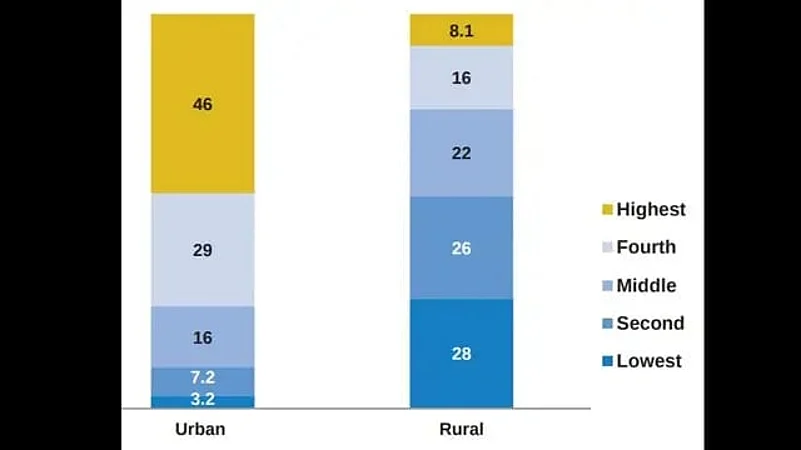The National Family Health Survey 2019-2021 has revealed that India’s urban areas had the highest number of wealthy households, with about 45.5 per cent of population in the highest wealth-slab.
Chandigarh had the highest percentage of wealthy households at 79.4 per cent, followed by Delhi 67.7 per cent and Punjab 60.6 per cent.
According to Raghvendra Nath, MD of portfolio management company Ladderup Wealth Management, “Increased awareness amongst the urban population has resulted in increased investments. Post-Covid, with improved digitalization, there is a huge influx of investors into equity investments.”
He added that “the government’s push towards financial inclusion via various initiatives has encouraged people to invest beyond traditional products.”

Key Findings Of The Survey
Unequal Wealth Distribution Pattern: Chandigarh, Delhi and Punjab had the highest number of rich people, but Jharkhand, Bihar, and Assam had the highest percentage of people living in the lowest wealth quintile at 45.9 per cent, 42.8 per cent and 38.1 per cent, respectively, the survey showed.
Also, 71 per cent of people belonging to scheduled tribes and 49 per cent people belonging to scheduled caste households were in the two lowest wealth-quintiles.
Further, 27.8 per cent of people in rural areas were in the lowest wealth quintile and 3.2 per cent of people in urban areas were in the lowest wealth-quintile.
In the highest wealth slab, about 45.5 per cent people lived in the urban areas and 8.1 per cent of people lived in the rural areas, the NFHS-5 data shows.
Says Rachit Chawla, CEO of financial services company Finway: “The growing wealth disparity between the urban and rural populations mostly stems from the disproportional gaps in opportunities. When we talk of the lowest wealth quintiles, we have to retrospect if those in these categories have the luxury of achieving their aspirations. Unless there’s collective effort across all segments of the society and economy, parity will remain a hot topic of conversation.”
Bank Or Post Office Accounts: Despite holding bank or post office accounts by most Indians, a significant portion of the population still lives below the poverty line.
The report showed that 95.3 per cent of people in urban areas had a bank or post office account and 95.9 per cent people in the rural areas had a bank or post office account, suggesting both urban and rural areas had similar percentage of people with bank accounts.
Regarding BPL cardholders (below poverty line), 31 per cent of people in the urban areas had a BPL card, while 52.1 per cent people in rural areas had one. This suggests a significant portion of people in both urban and rural areas were still living below the poverty line.
According to Mahesh Shukla, founder and CEO of PayMe India, a financial services company, Inflation can also be a reason behind the prevalent financial inequality "since during inflation a few profit earners get benefited and most wage earners lose. Generally, during inflation, wages of workers in the organized sector increase and those working in the unorganized sector suffer losses. There is also a significant gap in earning opportunities and high-salaried jobs between rural and urban India."
Also, about 33.4 per cent of children (both male and female) from rural and urban areas in the lowest wealth quintile attended pre-school, while the India average for pre-schoolers were 40.1 per cent.
"The reasons for wealth disparity between the urban and the rural populace may be unemployment, underemployment, and the consequent low productivity of people," added Shukla.
Girl Child School Enrollment Better Than 2015-2016 Levels: It was found that 28.2 per cent of girls had not completed schooling, compared 31 per cent in 2015-2016, the NFHS-4 data shows.
The number of girl child who completed at least 12 years or more of schooling has improved. A total of 16.6 per cent of girls have completed 12 or more years of schooling versus 13.7 per cent in 2015-2016.
According to Shukla, "There is a significant lack of opportunities for women in rural areas to clinch to higher income levels. There is also a mentality gap, hence, people across all segments should make efforts in bringing financial equality and address the opportunity gap in the country."
Commenting on these figures, Nath said, that because of greater awareness for education, and enrollment in schools, women now play a key role in financial planning.
“Their cautious approach motivates their spouse to do research more diligently and invest in a disciplined manner, restricting them from making impulsive decisions," he said.














